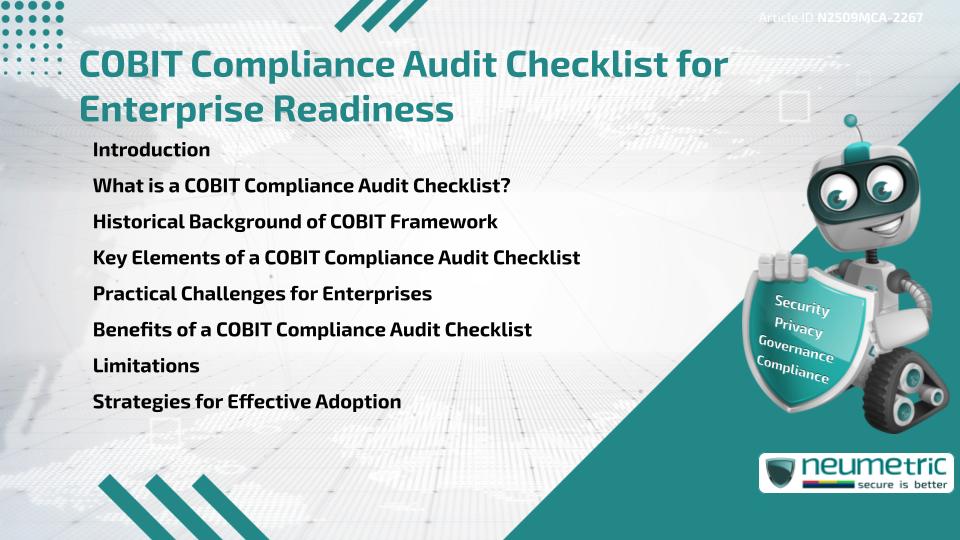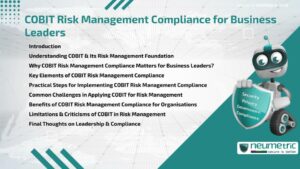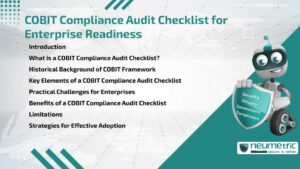Table of Contents
ToggleIntroduction
COBIT Compliance Audit Checklist is a valuable Tool for Enterprises preparing for IT Governance & Compliance Audits. COBIT, short for Control Objectives for Information & Related Technology, is a globally recognised Framework that helps organisations align IT processes with Business goals. A structured Audit Checklist ensures Enterprises meet Regulatory Standards, identify gaps & demonstrate Readiness to Auditors & Stakeholders.
What is a COBIT Compliance Audit Checklist?
A COBIT Compliance Audit Checklist is a structured Framework that guides organisations in evaluating their IT Governance, Risk Management & Compliance processes. It helps Auditors & IT leaders verify that Controls are implemented effectively & aligned with COBIT Principles. The Checklist covers areas such as Risk Assessment, Performance monitoring, Incident Management & Data Security.
Historical Background of COBIT Framework
COBIT was first introduced in the 1990s by ISACA as a Tool for IT Governance & control. Over time, it evolved into a comprehensive Framework addressing Enterprise IT Management, Risk & Compliance. Today, COBIT 2019 is the most widely used version, providing flexible Governance Models adaptable to diverse Industries. Regulatory Bodies & Auditors often reference COBIT when assessing IT Controls.
Key Elements of a COBIT Compliance Audit Checklist
An effective COBIT Compliance Audit Checklist typically includes:
- Assessment of IT Governance Policies & Alignment with Business Objectives
- Review of Risk Management Frameworks & Mitigation Strategies
- Evaluation of Access Controls, Data Security & Privacy Measures
- Monitoring of Performance Indicators & Reporting Systems
- Examination of Incident Response & Business Continuity Plans
- Validation of Compliance with Legal & Regulatory requirements
Further guidance is available from ISACA.
Practical Challenges for Enterprises
Enterprises may face obstacles when applying a COBIT Compliance Audit Checklist. Complex IT Environments often make it difficult to Map processes to COBIT Controls. Smaller businesses may lack Resources or expertise to conduct thorough Audits. Additionally, frequent updates to Regulatory requirements can complicate Compliance tracking & alignment.
Benefits of a COBIT Compliance Audit Checklist
Despite challenges, the Checklist provides clear benefits:
- Structured approach to evaluating IT Governance & Compliance
- Easier identification of Gaps & Risks before Formal Audits
- Stronger alignment of IT processes with Enterprise Goals
- Increased Stakeholder & Regulator confidence
- Improved Operational efficiency through Standardised Practices
Limitations
Some critics argue that the Checklist approach may oversimplify complex Governance requirements. Others caution against treating it as a One-time activity rather than part of Continuous Improvement. For smaller Enterprises, Costs & Resource commitments can also be significant Barriers.
Strategies for Effective Adoption
To maximise the value of a COBIT Compliance Audit Checklist, organisations should:
- Conduct regular Internal Audits, not just Annual reviews
- Involve Cross-functional Teams to ensure Broad coverage
- Train staff on COBIT Principles & Governance Best Practices
- Leverage Resources from NIST, OECD Governance Frameworks & World Bank insights for additional context
Takeaways
COBIT Compliance Audit Checklist is more than a Tool, it is a Roadmap for Enterprise Readiness. By using it consistently, organisations can identify Gaps, strengthen Governance & Build resilience while ensuring smoother Compliance Audits.
FAQ
What is a COBIT Compliance Audit Checklist?
It is a Structured Framework used to assess IT Governance, Risk Management & Compliance processes against COBIT Principles.
Why is the Checklist important for Enterprises?
It ensures Readiness for Audits, aligns IT with Business goals & identifies Governance Gaps.
What are the main elements of such a Checklist?
Risk Management, IT Governance Policies, Data Security, Compliance Measures & Performance Monitoring.
What challenges do Enterprises face?
Challenges include complexity of IT Environments, Resource Limitations & Evolving Regulations.
Does the Checklist guarantee Compliance?
No, but it provides a Structured approach to improve Readiness & Governance.
References
- ISACA – COBIT Framework
- NIST CyberSecurity Framework
- OECD Privacy Guidelines
- World Bank Digital Development
- ENISA – European Union Agency for CyberSecurity
Need help for Security, Privacy, Governance & VAPT?
Neumetric provides organisations the necessary help to achieve their CyberSecurity, Compliance, Governance, Privacy, Certifications & Pentesting needs.
Organisations & Businesses, specifically those which provide SaaS & AI Solutions in the Fintech, BFSI & other regulated sectors, usually need a CyberSecurity Partner for meeting & maintaining the ongoing Security & Privacy needs & requirements of their Enterprise Clients & Privacy conscious Customers.
SOC 2, ISO 27001, ISO 42001, NIST, HIPAA, HECVAT, EU GDPR are some of the Frameworks that are served by Fusion – a SaaS, multimodular, multitenant, centralised, automated, CyberSecurity & Compliance Management system.
Neumetric also provides Expert Services for technical Security which covers VAPT for Web Applications, APIs, iOS & Android Mobile Apps, Security Testing for AWS & other Cloud Environments & Cloud Infrastructure & other similar scopes.
Reach out to us by Email or filling out the Contact Form…





